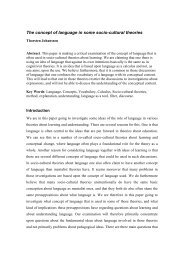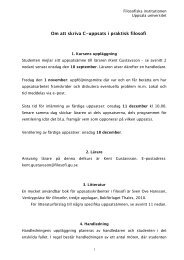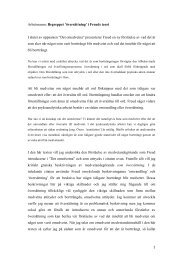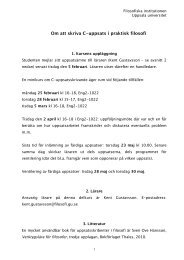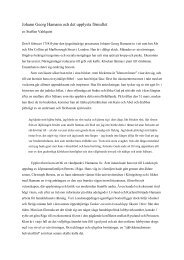1 Dewey, Wittgenstein, and Linguistic Instrumentalism My paper ...
1 Dewey, Wittgenstein, and Linguistic Instrumentalism My paper ...
1 Dewey, Wittgenstein, and Linguistic Instrumentalism My paper ...
Create successful ePaper yourself
Turn your PDF publications into a flip-book with our unique Google optimized e-Paper software.
as the pursuit of what <strong>Dewey</strong> calls “the quest for certainty.” 8<br />
Rorty specifically<br />
challenges Fodor (220 <strong>and</strong> elsewhere).<br />
Quine (1969) writes: “When we turn thus toward a naturalistic view of language<br />
<strong>and</strong> a behavioral view of meaning, what we give up is not just the museum figure of<br />
speech. We give up an assurance of determinacy” (28). He is correct. Quine uses<br />
<strong>Wittgenstein</strong> <strong>and</strong> <strong>Dewey</strong> to develop his own thesis of “ontological” indeterminacy,<br />
which goes far beyond the indeterminacy of ordinary translation:<br />
When . . . we recognize with <strong>Dewey</strong> that “meaning . . . is primarily a property of<br />
behavior,” we recognize that there are no meanings, nor likenesses nor<br />
distinctions of meaning, beyond what are implicit in people’s dispositions to<br />
overt behavior . . . . If by these st<strong>and</strong>ards there are indeterminate cases, so much<br />
the worse for the terminology of meaning <strong>and</strong> likeness of meaning. (29)<br />
In Quine’s “Ontological Relativity,” things turn out much the worse. The cor e of the<br />
argument derives from Quine’s example of an ostensive definition of “rabbit” in a<br />
hypothetical culture that uses “gavagai.” The ontological question is: Does it mean<br />
rabbit, “undetached rabbit part,” “rabbit stage,” or something else (30). The problem is<br />
that ostensive definition regardless of however much we come to agreement in action,<br />
fails to ultimately fix the meaning of “rabbit,” which may have an endless array of<br />
ontological assemblages. Identical twins raised in the same happy home may never be<br />
sure that they are in ontological agreement.<br />
With two such instances of internationally recognized philosophers such as<br />
Quine <strong>and</strong> Rorty not merely noting the similarity, but making extensive use of it to<br />
8




